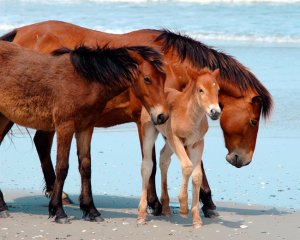By LAURA BEIL of The New York Times
Their numbers have dwindled to only a few hundred
COROLLA, N.C. — Come summer, the beaches of this barrier island will be choked with cars and sunbathers, but in the off-season the land is left to wild horses. Smallish, tending toward chestnut and black, they wander past deserted vacation rentals in harems of five or six.Thousands of them once roamed the length of the Outer Banks of North Carolina, the likely descendants from mounts that belonged to Spanish explorers five centuries ago. Now their numbers have dwindled to a few hundred, the best known living on federal parkland at Shackleford Banks.
But the largest herd, which has recently grown to almost 140 strong, occupies more than 7,500 acres of narrow land that stretches from the end of Highway 12 in Corolla (pronounced cor-AH-la) to the Virginia border, 11 miles north. Lacking natural predators, and trapped by fences that jut into the choppy Atlantic, the herd is becoming so inbred that its advocates fear a genetic collapse in mere generations.
These supporters are leading a campaign to save the Corolla herd, and they have powerful allies in Congress. In February, the House passed a bill that would sustain the herd at about 120 and allow the importing of new mares from Shackleford for an introduction of fresh genes.
Wildlife conservationists say the issue is not so simple. The beaches, marshes, grasslands and forests near Corolla are a stopover for flocks of endangered migratory birds, and nesting ground for sea turtles. Much of the horses’ range belongs to the Currituck National Wildlife Refuge, and defenders of the native habitat fear the herd’s current size strains the ecosystem.
The future of the horses raises larger questions about whether one animal should be preserved at the expense of others — and who gets to decide.
“This is about values,” said Michael Hutchins, executive director of the Wildlife Society, representing wildlife biologists and managers, which opposes the House measure. “I like horses; I think they are fascinating animals. I also deeply value what little we have left of our native species and their habitats.”
Both sides invoke science to their cause. But data are sparse and a comprehensive study of the horses’ impact is not expected before next year.
In the arena of political and public sentiment, the horses win hands down. Bonds between horse and human have existed for centuries; it is the animal that has pulled plows, and carried armies and settlers forward in the name of civilization.
“God has put such a beautiful thing here — how can you not want to protect them?” said Betty Lane, 70, who has lived here for more than 40 years, driving her S.U.V. as part of a citizen patrol to protect the horses. (She stopped after mistaking a reporter for a tourist trying to get too close to the horses, in defiance of local law.) She wore a necklace bearing the name Spec, for a stallion killed by a hit-and-run driver on the beach.
Dedication to wild horses runs so deep here and elsewhere that many supporters even chafe at the notion of calling the animals “non-native,” citing fossil records that horses lived in North America more than 11,000 years ago before going extinct along other Pleistocene creatures like mastodons.
The wild horses of Corolla did not arise here, but they are domestic animals that have lost their domesticity. Though skeptics question whether the horses are indeed Spanish, an inspection from the American Livestock Breeds Conservancy and other groups has noted the horses’ short backs, low-set tails and other traits that make them distinct from other North American stock. A DNA analysis published February in Animal Genetics also points to a common origin for the horses, suggesting they may be a living relic of an Iberian breed that exists nowhere else.
The study also confirms fears that the horses are growing perilously inbred. “There are wild herds with lower diversity, but not many,” said Gus Cothran, an expert in equine genetics at Texas A&M University who is lead author of the report. He says a herd of 60 could survive, provided a new mare entered the group every generation (about eight years). The federal bill sets a herd size at 110 to 130, the minimum number Dr. Cothran says could slow genetic erosion if the horses remain isolated.
“We are not asking for hundreds of horses,” said Karen McCalpin, director of the Corolla Wild Horse Fund, which protects and cares for the horses, and leads public education about them. The heart of the disagreement with wildlife conservationists is over how many horses the habitat can bear. “If they were that detrimental for the environment,” she asked, “wouldn’t that be evident by now?”
Click (HERE) to read the rest of the story at The New York Times
Related articles
- Bill to Increase Corolla Wild Horse Herd Passed by House (rtfitchauthor.com)


No comments:
Post a Comment